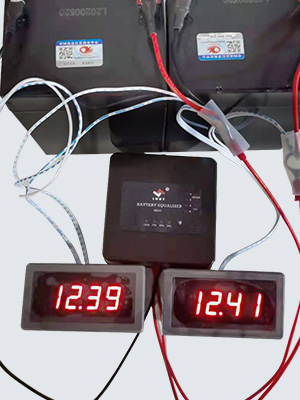At present, the batteries on the market are divided into two camps: lead-acid and lithium batteries. Lead-acid batteries and storage batteries are two types of batteries that are widely used at present. Both have their own advantages. Today, we will briefly analyze the comparison of the advantages and disadvantages of lead-acid batteries and lithium batteries.
1.Different memory effects
Lithium battery has no memory effect; the battery can be charged and discharged at any time, and the battery self-discharge is low. Lead-acid batteries have a memory effect, and cannot be charged and discharged at any time; there is a serious self-discharge phenomenon, and the battery is easily scrapped after being left for a period of time; the discharge rate is small, and it cannot be discharged with high current for a long time.
How to equalize the lead-acid battery voltage:

2.Working temperature is different
The common operating temperature of lithium batteries is -20-60 degrees Celsius, but generally the performance of lithium batteries will decline when it is lower than 0 degrees Celsius, and the discharge capacity will decrease accordingly. Therefore, the working temperature of lithium batteries with full performance is usually 0~40 degrees Celsius. The working temperature of lead-acid batteries is generally required to be between 20°C and 25°C. When the temperature is lower than 15°C, its discharge capacity will decrease. For every 1°C decrease in temperature, its capacity will decrease by 1%. Life expectancy will be greatly shortened.
3.Different working principles
Lithium-ion batteries are characterized by light weight and easy portability. Lithium-ion battery is a type of battery that uses lithium metal or lithium alloy as the negative electrode material and uses a non-aqueous electrolyte solution. Lead-acid batteries can store limited electrical energy and use it in a suitable place. It works by converting chemical energy into electrical energy. It uses a lead plate filled with spongy lead as the negative electrode, a lead plate filled with lead dioxide as the positive electrode, and 22 to 28% dilute sulfuric acid as the electrolyte. During charging, electrical energy is converted into chemical energy, and during discharging, chemical energy is converted into electrical energy.
4.The usage is different
The advantages of lead-acid batteries are cheap price, good safety, no danger of burning, large discharge current, usually within 5c, and low temperature resistance, and can release nearly half of the electric energy at minus 30 degrees. Compared with lead-acid batteries, lithium batteries are light in weight, large in capacity, and have a single voltage of 3.7~4.2v. This feature is very suitable for electrical appliances that require high weight and volume, such as portable appliances, mobile phones, notebooks, flashlights, etc.
5.Different security
The disadvantage of lithium batteries is that the price is high, and the positive and negative electrode materials use precious metals. The second is that the electrode materials use lithium compounds. Lithium is an active metal. When encountering oxygen and improper charging and discharging, it will release a large amount of heat energy and produce a violent oxidation reaction. Because lithium batteries are usually sealed in rigid containers, rapid temperature rises will inevitably lead to pressure rises, which may cause explosions. In order to control this unsafety, lithium batteries and their combinations must have a circuit board to control the charge and discharge current and voltage. , Also called the protection board. It is also for this reason that lithium batteries cannot be discharged with large currents at will, and the discharge activity becomes poor under low temperature conditions.
